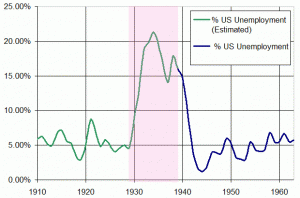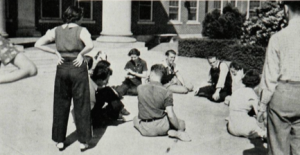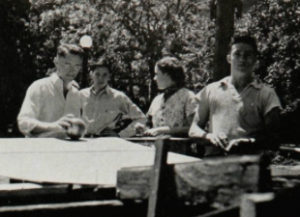
by Marie Crommett
During the 1930s depreciated finances, a depressed stock market, and a nation in between two world wars dominated the student environment on Baylor’s campus. Often when the Baylor newspaper, The Lariat, went to print it featured stories of a nation under financial crisis. Inaugurated in 1932, President of Baylor University, Pat Neff, was faced with a university with limited finances, decreasing enrollment rates, and a nation more focused on joining the workforce than going to college. This apathetic and distressed environment created an opportunity for higher education professionals to give life back to their university and provide students with meaningful programs to increase the quality of the student experience. The formation of All-University Holiday—later known as Dia Del Oso—served as a time “to give the students a day off from their studies,” according to President Pat Neff (Hatchett & Stone, 1932, p. 1).

Many students during this time understood that college was both a luxury and a burden. Therefore, many students were employed in addition to being a full-time student. This strain on finances and studies created a conflicting experience or students at Baylor in the 1930s and in universities across the nation. In wake of this financial crisis, President Pat Neff declared in 1932, short after his inauguration, that Baylor University would suspend classes for one day. This day was designed to give students a break from classes; however, it was also designed to give students a break from the reality of their hardships and allow them one day of release to develop fellowship with students, faculty, and their university.
All-University Holiday provided students with more than a day off; it provided a day of release from each student’s burden of financial struggles, constituted Baylor’s aim to create a holistic and safe environment for their students, and became an avenue for students to participate in activities that delineated the reality of their depressive circumstances.
Historical Context: The Great Depression.
Stock Market Crash
According to Maury Klein (2001) in The Stock Market Crash of 1929: a Review Article, a spectrum of factors contributed to the fall of the stock market and the beginning of the great depression. Klein (2001) says, “The stock market crash of 1929 suggests that the disagreements and debates over the crash reveal as much about what can and cannot be known for certain about the event as much as they do about potential answer to the mysteries of the crash” (p. 325). Therefore, the following are assumptions, ideas, and hypothesis attempting to answer the mysteries of the stock market crash.
One of the first causes of the great depression singled out the Federal Reserve System as fundamentally and primarily a cause of the panic of 1929 by permitting the use of banking funds in an unduly large degree and without adequate protection, in promoting speculation (Klein, 2001). Furthermore, Klein (2001) argues that the “grand illusion of the new era [was] that the relatively new Federal Reserve System could use its instruments of currency and credit control to prevent extremes of boom and bust from occurring” (p. 333). This illusion expected to end the monopolistic business cycle. However, the Federal Reserve inflated credit and resulted in a flawed banking system.
Additionally, according to Klein (2001), if there is a common thread running through literature on the stock market crash, it is an emphasis to varying degrees on the irrational element in investors’ behavior and the growing sense of illusion or euphoria that infused their view of the market. This element resulted in what Klein (2001) describes as a “vacuum of belief,” where uncertainty of future prospects arose and strongly infected attitudes following the 1929 crash (p. 339).
These attitudes extended across the United States, even to private Texas institutions, like Baylor University, whose finances were dependent upon the banking system and the idealized fantasy of a highly speculative market. The crash was the dividing point between “unbounded optimism and uncontainable pessimism” (Klein, 2001, p. 344).
Baylor University Finances.
Debt
Due to the stock market crash, universities struggled to reimburse banks on loans made in the previous decade. “On November 24, 1922, the records show that a note for $25,000 was renewed at the First National Bank of Waco” (Neff, 1937). In this speech, Neff (1937) also stated that “in 1924 Baylor University issued bonds that amounted in $200,000 in order to assume title to the property on which Brooks Hall [was] located. As this time is [also] borrowed $15,000 for the general fund of the institution”. Additionally, Neff (1937) stated that:
“These various items of outstanding indebtedness were lessened, but the notes gradually piled up more debts against it until September 1932; at that time the university was so involved that it could not borrow any money from any Waco bank or from any individuals. Salaries of faculty
members and employees of the university had not been paid for June, July or August. There was no money in the treasury. There was an indebtedness of $376,428.15.”
Additionally, in this report to the campus, Neff (1937) states:
“a letter from the cashier of Baylor University dated April, 26, 1937 shows that since September, 1932 out of the savings of Baylor University without receiving $1 income from the endowment the institution had paid on the above sum of indebtedness $242,556, leaving at that time an aggregate indebtedness against the university, including unpaid book salaries, $133,671.85.”
As seen from Klein (2001), the attribution of indebtedness is directly correlated to flawed banking practices and over speculation of market prosperity from the decade earlier. Therefore, it is apparent that Baylor University resembled hundreds of universities during this era. As Baylor was not able to pay back the First National Bank of Waco, similarly, other universities were not able to meet their financial obligations. This resulted in University debt for Baylor as well as widespread national debt for many institutions.
Formation of All-University Holiday.
Purpose
All-University Holiday is a day where “Baylor’s four classes and the faculty will forget the classroom, academic study and will band together in one big play day…when the All-University day again takes place on the calendar as a holiday” (Ferguson, 1937, p. 1). According to the Baylor University Newspaper, The Daily Lariat, “the faculty has been gracious enough in cooperation by offering a full holiday in the event that students show enough interest in the project” (All-University Day, 1932, p. 2). Faculty, administration, and students alike supported the formation of All-University holiday, as well as its purpose of creating community and fellowship. Additionally, a publication by The Daily Lariat in 1932, states that All-University Day:
“Is such a day as students with red blood in their veins have been [yearning] for these many years. It is a day through which the university hopes to promote the social understanding of its student body. It is a day on which the whole university population will frolic with but two aims in mind—to have a good time and to know each other better” (All-University Day, 1932, p. 2).
Baylor was not alone in its venture to create a day specifically designed to enrich the student experience. According to The Daily Lariat, “larger universities of the nation have such days and have found them a vital part of the university life. They are days looked forward to with as much anticipation as the freshman looks to Christmas holidays” (All-University Day, 1932, p. 2). Although this statement may be hyperbolic, in 1932, this level of excitement to have a day of enjoyment free from stress or pain was like a holiday. Additionally, this statement reflects a trend in higher education that was not exclusive to Baylor: value on the student experience. Baylor, alongside other universities in America, began to realize the importance of the spirit and tradition of university programming and its affect on the student experience.

For that reason, the spirit and purpose of All-University day is best surmised an article in The Daily Lariat published just days before the event were to first take place:
All-University Day is a big thing. That is the reason it is not possible for all students to grasp the meaning of it at once. Big things like big men come in for their big share of criticism and praise. This year marks the beginning of a stupendous proposition. The continuance of it depends on the support it receives from every student on the campus, because it is just what the name implies—all-University Day (All-University Day, 1932, p. 2).
Events

In 1932, programs for all-university were both overflowing and undocumented. According to The Daily Lariat, “plans for the day call for something each minute of the hours spent. There is not an idle minute anticipated. The program is one that is so varied it cannot fail to interest everyone. It is a day packed to the brim with exciting events” (All-University Day, 1932, p. 2). However, in this brief, there is no mention of specific programs. Only in a later Daily Lariat publication in 1937 would the shaping of the day begin to unfold. According to The Daily Lariat, “beginning at 7:30 o’clock in the morning and lasting until 4:30 p.m. a schedule of 99 events will be held over campus. In each of these events the four classes and the faculty will have representatives to battle for the honors” (Ferguson, 1937, p. 1). Additionally, “booths will be placed at strategic points on the campus Thursday, Friday, and Monday for the students, both men and women, to sign up for various events” (Ferguson, 1937, p. 1). Furthermore, “contests that should be popular with the students include such games as mumble peg, jacks, tennis, bicycle race, donkey race, hopscotch, marbles, leap frog, and the honeymoon relay race” (Ferguson, 1937, p. 1). Finally, the final portion of this article details an extraordinary new event that will take place:
“A new feature has been added that will literally put mud in somebody’s eye—tug-o-war—in which [a] slush pit will separate the two contestants. For hilarity, the chairman suggests the honeymoon race, which consists of a boy and a girl running to a designated spot with a suitcase, opening it, putting on the clothes therein and returning to the starting line” (Ferguson, 1937, p. 1).
The events taking place on All-University seem frivolous and foolish in a way, however, the symbol of fellowship, team-building, and fellowship that was created is the much greater takeaway from these events and this day.
Results of All-University Holiday.
The most recent All-University Holiday was celebrated in April 2014, nearly 80 years after its commencement. While the name has since been changed to “Dia Del Oso,” meaning “day of the bear,” in 1966 due to a student vote, the spirit of the event has remained steadfast (Diadeloso, 2014).
Students in 1932 lived through the stock market crash, the First World War, and a severe economic depression. Nearly ten years later they would be faced with another travesty: Pearl Harbor and World War II. Though life outside the University was chaotic and unpredictable, there was one day a year that was not: All-University Holiday. Students, faculty, and administrators alike were able to fill their day with frivolity, friendship, and fun, with little to no worries about the cares of the outside world. Although the day was free from classes, seemed unnecessary, and deferred from tradition, the deference of the student body on the event meant the beginning of a new tradition. This tradition still lives on today through the life of Baylor University.
Discussion.
“The best part of a university is invisible. At least sixty percent of all university education is atmospheric. What a student studies is not as important as the atmosphere in which he studies. If a denominational university does not stand for something in addition to what a student can get out of a book then there is no justification for its existence” (Neff, 1932).
All-University Holiday represents that desired atmosphere Neff describes. Depreciated finances, a depressed stock market, and a nation in between two world wars may have dominated the country as a whole; however, it did not restrain Baylor University from providing a time for fun and comradeship.
All-University Holiday provided students with more than a day off; it provided a day of release from each student’s burden of financial struggles, constituted Baylor’s aim to create a holistic and safe environment for their students, and became an avenue for students to participate in activities that delineated the reality of their depressive circumstances. Finally, All-University Day served as an ideological symbol of fellowship, comradeship, and Sabbath in a community of economic depression and hardship. The Great Depression crippled the American economy in the 1930s; however, again, it did not cripple the spirit of Baylor University.
References.
All-University Holiday. (1932, April 14). The Daily Lariat, p. 2.
Diadeloso. (2014). Retrieved from http://www.baylor.edu/diadeloso/
Ferguson, Joe. (1937, April 28). All-Univeristy Day Plans, May 5, Near Completion. The Daily Lariat, p. 1.
Hatchett & Stone. (1932, April 12). Faculty Approves All-University Holiday. The Daily Lariat, p. 1.
Klein, M. (2001). The stock market crash of 1929: A review article. Business History Review, 75(2), 325-351.
Muljadi, Paul. (2011). Great Depression.
Neff, Patt. (1932). Patt Neff Series V–Personal. Texas Collection, 15(5).
Neff, Patt. (1937). Patt Neff Series V–Personal. Texas Collection, 15(14).
Thelin, John R. (2004). A History of American Higher Education (2nd ed.). Baltimore, MD: Johns Hopkins University Press.